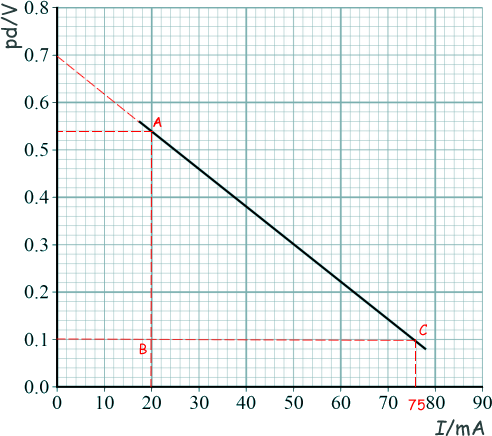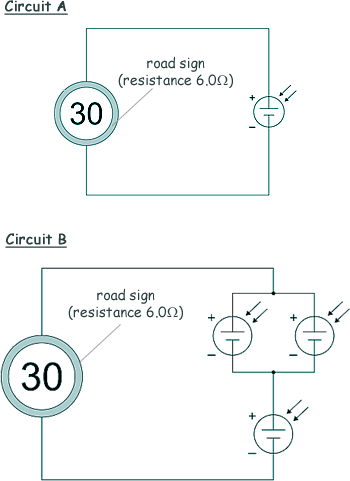Practical electricity experiment questions
Q2.
(a) An engineer wants to use solar cells to provide energy for a filament lamp in a road sign.
The engineer first investigates the emf and internal resistance of a solar cell under typical operating conditions. She determines how the potential difference across the solar cell varies with current.
The results are shown in the graph in below:

(i) The engineer used the graph to deduce that when operating in typical conditions a single solar cell produces an emf of 0.70 V and has an internal resistance of 8 Ω.
Explain how she used the graph to obtain the values for the emf and internal resistance of the solar cell.
EMF = I(R + r)
pd = -rI + EMF
The EMF is therefore the intercept on the Y axis
When current is zero pd = 0.70V (see graph). This is the EMF - QED 
The internal resistance is the negative value of the gradient of the graph:
AB = 0.54 - 0.10 = 0.44 V
BC = 20 -76 = - 56 mA = - 56 x 10-3 A
gradient = AB/BC
= 0.44/-(56 x 10-3)
-r = -7.9 Ω 
therefore r ≈ 8 Ω
[2 marks]
(ii) To operate effectively the lamp in the road sign needs a minimum current of 75 mA.
At this current the resistance of the filament lamp is 6.0 Ω.
The engineer proposes to try the two circuits shown below:

Deduce, using calculations, whether the circuits are suitable for this application.
Circuit A
EMF = 0.70 V
r = 8.0 Ω
R = 6.0 Ω
EMF = I(R + r)
0.70 = I x 14
I = 0.70/14 = 0.050A
Therefore the cell supplies only 50 mA - below the 75 mA required and would not be suitable. 
Circuit B
EMF = 1.4 V  .
.
r = 12 Ω  resistors in series and parallel
resistors in series and parallel
R = 6.0 Ω
EMF = I(R + r)
1.4 = I x 18
I = 1.4/18 = 0.078A 
Therefore the cell supplies 78 mA - above the 75 mA required and would be suitable.
[4 marks]
(b) Solar cells convert solar energy to useful electrical energy in the road sign with an efficiency of 4.0%. The solar-cell supply used by the engineer has a total surface area of 32 cm2 .
Calculate the minimum intensity, in W m–2 , of the sunlight needed to provide the minimum current of 75 mA to the road sign when it has a resistance of 6.0 Ω.
Power needed to run the sign
P = IV = I2R
P = (75 x 10-3)2 x 6.0
P = 0.0338 W 
But this is only 4% of the power that has to be supplied to it -
Power needed = 100 x 0.0338/4 = 0.844 W 
Intensity = power/area
= 0.844/(32 x 10-4)
264 W/m2 
[3 marks]
(Total 9 marks)








